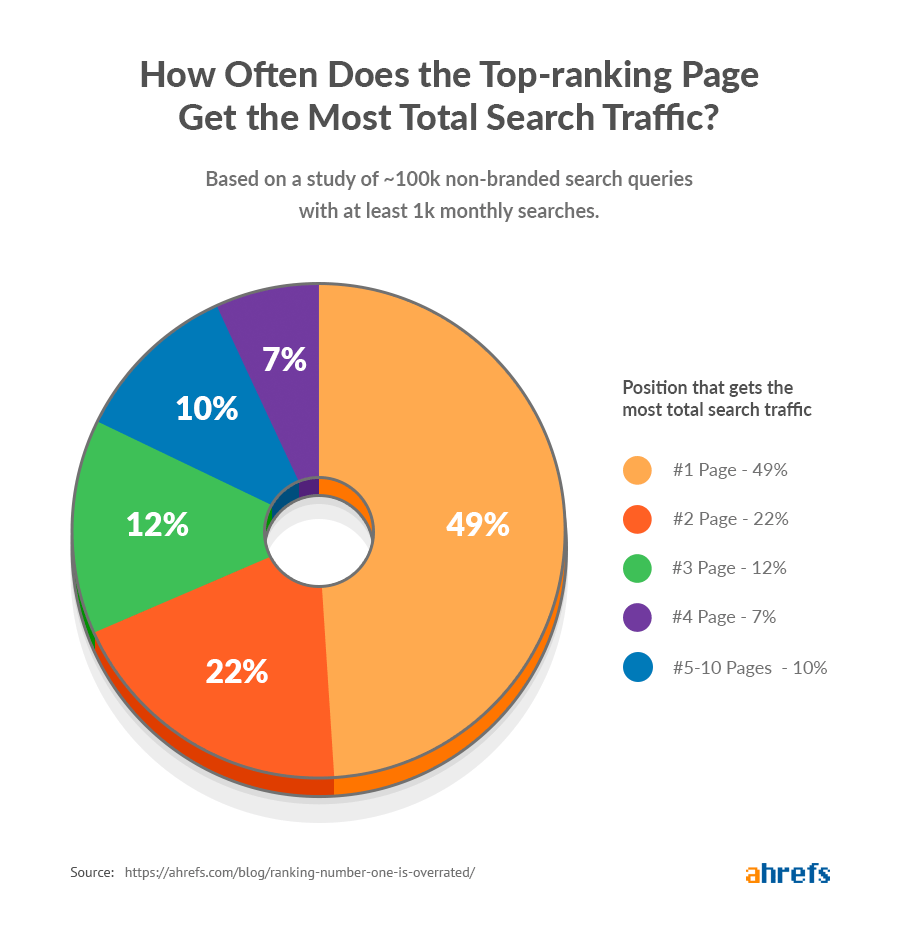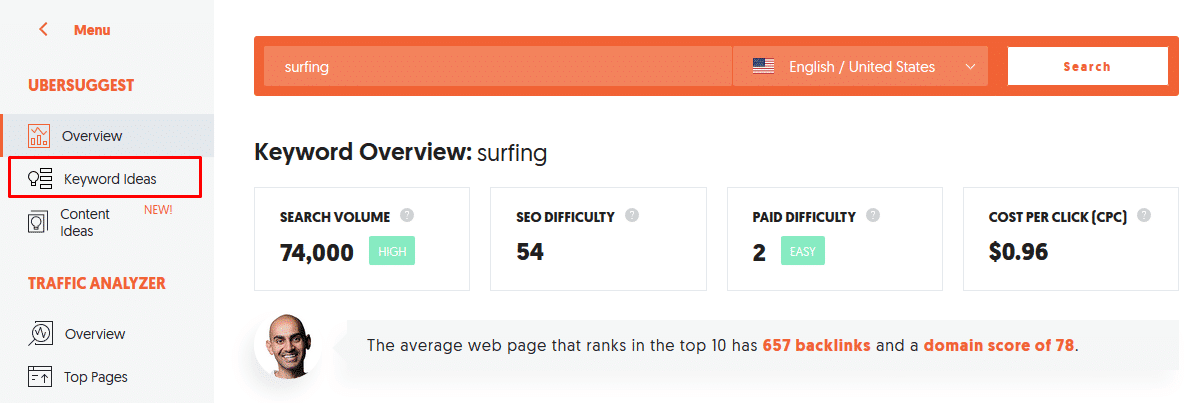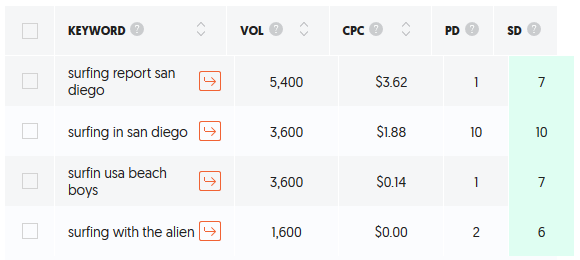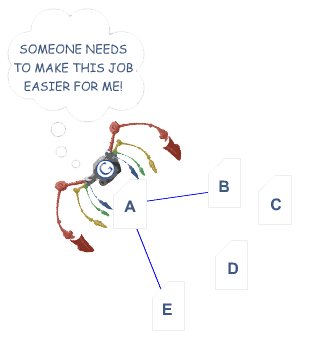
Too many business owners put blogging in a box.
They think of writing blog posts as a way to inform their customers of new products, company updates, and maybe the occasional sale. While there’s nothing wrong with including such posts on your blog, that’s not where the real value of blogging comes from.
The real value of blogging is:
In this guide, you’ll learn how to write blog content that actually ranks and brings your business tangible value.
Here’s what we’re going to cover:
Before getting into the specifics of topic research and content creation, it’s important to understand the goal, the look, and the user experience that is required to get a blog post to the front page.
To win the rankings battle, your blog posts must provide massive value. Your audience is investing valuable time reading your posts, and you need to make sure their investment is worthwhile.
To my mind, ensuring your content provides value is a prerequisite for rankings — in the same way that you must ante to be dealt a hand in a poker game. Creating valuable content will not single handedly help you gain more traffic from search engines, but doing so allows you to compete.
Ways to provide value include, but are not limited to:
No matter how much time you spend packing valuable information and resources into your blog post, it won’t matter unless you provide a good experience
If your readers have to dig through extraneous information, overlook annoying advertisements, or overcome technical obstacles, they won’t stay on your website.
This is important not just because it damages your rapport with the reader. It also hurts your rankings by increasing your site’s bounce rate while reducing its average session duration and pages per session — all metrics that are almost certainly weighed by Google’s algorithm and correlate to rankings.
There’s a good chance you already know that a successful blog post includes use/repetition of the target keyword(s). What you may not know is that the importance of this process is oftentimes overblown.
While it is generally important to mention your target keyword, you’ll want to avoid keyword stuffing (in your body text and your image alt text). Not only do such practices hurt your reader’s experience, they can get you penalized by the search engines, who see keyword stuffing as you trying to game their system.
Search engines hate when people try to game their system.
Most people don’t think too much about their readers (or search engines) when coming up with content ideas. They just write about whatever they fancy.
This quote from Joshua Hardwick (Ahrefs’ Head of Content) describes a critical mistake commonly made by content creators/managers when planning website content.
The presence of content with little-to-no strategic value is the #1 easiest way to tell that a website lacks a coherent content strategy (perhaps other than a lack of content altogether).
When you’re an industry insider, it’s easy to think you know exactly what content your readers will want to see. Getting lost in your own perspective in this way is a pitfall you must avoid if you want to win the rankings battle.
Rather than coming up with topics based on your intuition or personal experience, do so based on organic search traffic potential and business value. To quote RankFire CEO Matt Colletta:
You need to make content that people are actually searching for. Anything else is a prayer in the wind.
To avoid making prayer-in-the-wind content, you’ll need a keyword research tool or two.
At RankFire, we leverage premium, advanced SEO tools (including Ahrefs and ClearScope) to find the most valuable topics and optimize content, which gives our clients a big leg-up on their competitors.
However, there are free tools that can help kickstart your SEO. Here are some of my favorites:
Let’s go over how to measure a keyword’s search traffic potential and business value — I’ll use UberSuggest so you can follow along on your own.
A keyword’s search traffic potential can be estimated by looking at two metrics:
Almost every keyword research tool displays these two metrics, though sometimes with a slightly different name (e.g. UberSuggest calls it “SEO Difficulty”). Let’s look up the keyword “florist denver” to see these metrics in action:

The exact amount of traffic that would come with ranking for this keyword will vary, but Ahrefs ran a helpful study and came up with these results:

49% of traffic goes to the top spot. So, if you ranked #1 for “florist denver”, you could reasonably expect to get roughly 1,200 of the keyword’s 2,400 monthly searchers to visit your site. (Remember, these numbers are not precise and should only be used as estimates.)
A keyword has high business value when there is a direct relationship between the keyword and leads/sales — what we call “buying intent”. Here are a few examples of keywords with high buying intent:
The traffic that comes with keywords like this is very valuable because the users are clearly ready to make a purchase.
Keep in mind that it’s not necessary for every keyword you target to be able to have such a direct relationship to leads or sales. Ranking for keywords without buying intent can still be valuable for your business. Doing so “powers up” your site in the eyes of the search engines, which puts you in a position to rank for more keywords, which gets you more traffic, which gets you more leads/sales.
Now, let’s run through an example of how to choose a target keyword that’s worth writing about:
Suppose you own a business that sells surfboards online and you’re ready to start a blog to capture more search traffic. To get topic ideas, you can type a broad keyword like “surfing” into UberSuggest and click “topic ideas” on the left sidebar.

You should now see a myriad of keyword ideas, including some very valuable and competitive ones like “surfing board” (60.5k searches, 67 difficulty). Let’s filter the list to only show keywords with a reasonable number of searches (over 1,000) and a low difficulty rating (under 10).

Of these filtered keywords, “surfing in san diego” is the best fit for a blog post. (“Surfing report san diego” does not seem like something that could be covered with a blog post, and the last two options are music-related keywords not actually related to surfing.)
Let’s keep this target keyword in mind and move on to step 2.
Based purely on your intuition, you could probably come up with a few topic ideas for the keyword “surfing in san diego”, but relying on your intuition is a losing strategy in SEO.
You’re much better off basing your topic on “searcher intent” — what users are expecting/wanting to see when they search for the keyword.
To identify the searcher intent of a keyword, simply type it into Google. Make sure you use a private/incognito window, otherwise Google might give you different results based on your search history and behavior.
When you search for “surfing in san diego”, for example, the top 5 results are all lists of the best places to — you guessed it — surf in San Diego:

By looking at these results, you would be correct to conclude that the most effective way to target this keyword is to write your own list of the best places to surf in San Diego. You also may want to include some extra information based on the other results on the front page (more on this in a moment).
Now that you have your topic, it’s time to study the competition. Your goal in this step is to leverage the work of your competitors to come up with an outline and write a post that is significantly better than all of them (SEOs call this the skyscraper technique).
First, you’ll want to open every result on the front page to see exactly what’s being covered. Here’s a quick breakdown of the top 7:
When creating your outline, you need to take into account each of these results. Here’s what your outline might look like:
Notice that this outline includes everything covered by the websites currently on the front page, which ensures that your post will satisfy the searcher’s intent.
It’s finally time to write! Luckily, completing the previous steps makes this pretty easy.
Draft your post by filling in the outline, using your competitors’ pages any any other relevant information (including your personal knowledge) as resources.
We highly recommend getting your draft down relatively quickly. Don’t sweat the small stuff yet. Get the draft written and improve it in the editing process later.
After you’ve finished drafting your main text, it’s time to write your intro. You read that right — the intro is a post-draft task. Allow us to explain.
The primary goal of an intro is to compel the reader to continue reading. You need to gain their trust and convince them that they’ve landed on the page that will satisfy their query. And you only have a handful of sentences to do it.
Accomplishing this goal is magnitudes easier when your post is already written because you know exactly what the reader is about to read. This allows you to explain exactly what they’ll gain by continuing, tease the most valuable sections of your post, and provide any necessary context.
There’s no template or one-size-fits-all approach for writing intros, but you’ll never write a bad intro if you aim to do these three things (credit to Ahrefs’ Joshua Hardwick in this post):
If you need intro-inspiration, browse blog posts from successful sites like HubSpot or CopyBlogger. We have an intense habit of studying the latter’s writing strategies since copywriting is their specialty.
The editing process is the time to trim and refine your post to provide your readers with the best possible experience.
Besides your standard proofreading to fix typos and improve wording, here are some things you can do to improve your post in the editing process:
Linking to your new post from other pages on your website improves your site’s link structure and your new post’s ability to rank.
Google likes to rank sites with easily crawlable link structures that make sense because it makes their A.I.’s job easier. This infographic from Moz does a good job summing it up (and makes us laugh):

The Google spider has crawled page “A” and is able to follow internal links to crawl “B” and “E” as well. But pages “D” and “C” aren’t anywhere to found via internal links. These uncrawled pages basically don’t exist in the eyes of Google.
To avoid being neglected by the Google spider, make sure your new post is linked to from every page on your site that makes sense. Some of these links will be built automatically, like the one from your blog post’s corresponding category page (e.g. a lemonade recipe would be linked to from your “Recipes” page).
You should also link to your new post from some of your other blog posts. An easy way to find good opportunities is to use Google’s site search feature. Simply type “site:yoursite.com keyword” into Google to see a list of pages from which to link.
For example, say you run the travel blog backpackingmatt.com and you just published a new post about things to do in Peru. Wouldn’t it be nice to snap your fingers and have every mention of “Peru” on your site link to this new post?
This technique is not that fast, but it’s just about as easy.
Typing “site:backpackingmatt.com peru” into Google will show you every page on your site that mentions Peru:

Now, you’d simply open each page and add a link to your new post with the anchor text “Peru”. BAM! You’ve just built several valuable internal links in just a few minutes.
The number of unique websites that link to your post/domain is one of the most consequential ranking factors.
Building links is one of our specialties at RankFire, but the process for attaining them is complex and beyond the scope of this guide. Here are a few techniques and resources you can try on your own:
This is far from an exhaustive list of backlink building techniques, but it should get you started on the right track.
Link velocity is essentially the rate at which a website acquires backlinks. Your site’s link velocity needs to look natural (like the links were acquired organically).
You do not want your site to have a consistent link velocity because Google could see it as unnatural link building. Think about it: would an authoritative site like the New York Times or Forbes receive a very similar number of links every day/week/month? Absolutely not.
This is why a consistent link velocity can reduce the effectiveness of your links, or even lead to a penalty. Remember, the search engines hate when people try to game them.
For example, building 10 links per month, every month, would be less effective than building 15 links one month and 5 links the next. When we build links for our RankFire clients, we prioritize keeping a sharp eye on their link velocity to ensure maximal results.
You may have already published and promoted your post, but you aren’t done yet!
You worked hard on this post, and it would be foolish to not try to get maximum value out of it. To do so, you need to revisit the post once its had time to attain some rankings.
From there, you can try a number of strategies to improve its rankings:
You can also just update/improve the post with new information and change the publish date — Google loves to see that, though it may not prove as effective as the techniques above.
If you nailed your post on the first try and its ranking high for your target keyword (and related longtail keywords), you should usually avoid making any big changes to your post. You can still make some small tweaks — Google won’t mind if you fix typos or re-word sentences — but a dramatic update may do more harm than good.
SEO is complex, but this writing process isn’t.
Choosing a valuable topic, identifying searcher intent, and writing a great post is really all you have to do to start attaining rankings.
Well, you actually have to do one more thing: wait. A site’s SEO is not typically something that improves overnight, and it can feel like a slog. But your patience will pay off with the right level of execution.
If you want to avoid the SEO slog and get more traffic/leads without wasting time and money, schedule a free consultation now.